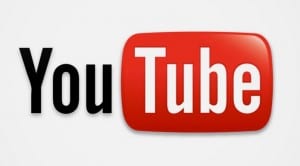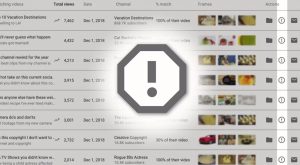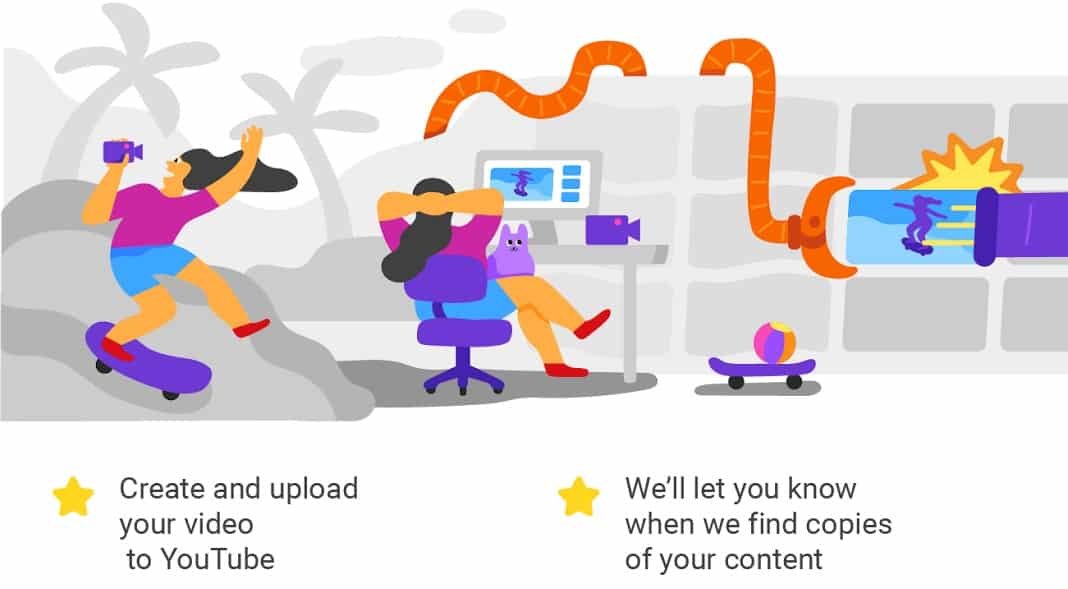YouTube Rolling Out Copyright Match
Matchmaker matchmaker make me a match.
 Back in May, we reported on how YouTube was beta testing Copyright Match, a new tool that made Content ID-like technology available to all users.
Back in May, we reported on how YouTube was beta testing Copyright Match, a new tool that made Content ID-like technology available to all users.
Well, the beta testing appears to have been successful as Yesterday YouTube announced on its Creator Blog that it was rolling out the feature to all users, starting with those with more than 100,000 subscribers and then to smaller channels later.
However, the announcement also contained two very important new pieces of information about Copyright Match, neither of them good news if you’re hoping for a useful and widely-available service.
First, Copyright Match will only be available to users that are already members of YouTube’s Partner Program, which limits participation to channels above a certain size. This means that new channels or small channels will not be able to participate in Copyright Match.
Second, Copyright Match will only work with full and complete matches not clips or partial videos. Though the post says it will work on matches that are “the same or very similar” it also makes it clear that Copyright Match “is intended to find full re-uploads”.
These changes greatly limit the usefulness of Copyright Match, both as an anti-spam tool and as a copyright tool, but it still may still be a first step for YouTube in dealing with its spam and misuse issues if YouTube is able to expand it over time.
The Idea Behind Copyright Match
 Since 2007, YouTube has had Content ID, an automated tool for detecting uploaded videos that contained video and/or audio content from unauthorized sources.
Since 2007, YouTube has had Content ID, an automated tool for detecting uploaded videos that contained video and/or audio content from unauthorized sources.
The tool has been heavily used by TV, movie and music studios to detect when unauthorized content is uploaded to YouTube in an effort to either block the content or monetize it for its original creator.
Though Content ID has proved useful for YouTube, currently handling more than 98% of all of its copyright disputes, it’s also been a source of controversy with many of its users complaining of false matches and fair use issues.
For creators wanting to protect their work, the big limitation has been the ability to get your content into YouTube’s Content ID system. Nowhere has this been more difficult than for YouTubers themselves who, despite often being major producers reaching millions of people, have generally not been able to protect their videos with Content ID.
Copyright Match brings a stripped down version of Content ID to everyday YouTubers. The system, like Content ID, detects when user content is re-uploaded onto the site and gives the original uploader a choice of action. They can either do nothing, contact the channel directly or remove it.
But, where Content ID is a proactive system (meaning it can stop infringing uploads before they go live), Copyright Match is reactive, only working on already-uploaded videos. Also, where Content ID matches are not part of the Digital Millennium Copyright Act notice-and-takedown process, Copyright Match removals appear to be. This means that videos removed through Copyright Match are not only subject to counternotices, but also to copyright strikes.
In short, Copyright Match brings Content ID’s technology to bear but only to aid in the finding of very specific infringements and to streamline the same removal process that YouTubers already had.
Copyright Match is not “Content ID for All” as it originally seemed to be and that may be its greatest strength and its biggest weakness.
The Limitations of Copyright Match
Many of the limitations of Copyright Match were made clear in the previous announcement, those limitations included:
- Inability to Monetize Unauthorized Content: Content ID lets rightsholders monetize unauthorized use of their material, Copyright Match only allows users to track or remove such videos.
- Complaints Handled Via DMCA: Content ID created a copyright process outside of the DMCA, Copyright Match requires DMCA notices.
- Reactive Instead of Proactive: Copyright Match only works on already-uploaded videos and cannot block infringing material from appearing.
While these limitations are significant, they also make a degree of sense. Giving millions of YouTubers, most of whom have little experience with copyright issues, access to a full version of Content ID is a recipe for chaos.
However, the new announcement presents two new limitations, both of which combine to hamstring Copyright Match’s ability to effectively address YouTube’s copyright and spam issues:
- Only Detects Full Re-uploads: Copyright Match will only spot when a video is re-uploaded to the site. This means that clips, edits or other partial uses of a video will not appear, regardless of how extensive they are.
- Limited to YouTube Partners: Copyright Match is only for members of YouTube’s Partner Program, meaning that smaller channels or channels that don’t wish to participate will be left out.
Copyright Match is clearly designed to address the ongoing issue of YouTubers, in particular spammy accounts, stealing content from other YouTubers. However, these two limitations make it very easy for such accounts to keep taking content.
Spammers or infringers simply have to either limit their lifting from smaller accounts or modify the video. Considering how we already see automated trickery in an attempt to fool Content ID, Copyright Match’s limitations make it likely these tactics will be effective, depending upon how well the matching works.
The other problem is that, while re-uploads are certainly an issue on YouTube, most of the major content controversies have centered around things like reaction videos, where users use either whole or significant portions of videos well outside the bounds fo fair use. Copyright Match will not likely address these cases, at least in its initial iteration.
If YouTube’s goal with Copyright Match is to reduce or stop spam/infringing channels, they can’t give bad actors easy ways to skirt the system. As Google has learned when fighting search engine spam, spammers are highly adaptive and will seize upon any means they can find to escape detection.
Unfortunately, even before its launch, Copyright Match has its bypasses built in and publicly visible. Copyright Match may improve the spam and infringement situation on YouTube, but it won’t fix it.
Bottom Line
When it’s launched, Copyright Match won’t be available to many YouTubers (including me), will only detect complete re-uploads and will still carry all of the original limitations we learned about in May.
While this is disappointing. the hope is that this is just the initial iteration of Copyright Match.
It makes sense to start out Copyright Match in a limited capacity. YouTube does have a re-upload problem, even if it hasn’t always been at the front of the coverage, and it’s the easiest to tackle since such videos are, except in rare cases, pretty clear copyright infringements.
This lets YouTube implement Copyright Match in a way that minimizes potential misuse, while still providing some usability. There will undoubtedly be a deluge of copyright notices as Copyright Match rolls out and this may simply be the lower-hanging fruit YouTube is choosing to tackle first.
Still, it would be nice if Copyright Match weren’t tied to its Partner Program, especially considering YouTube just raised the requirements and excluded many previous participants, and if Copyright Match detected modified infringements that are still egregious and obvious.
Copyright Match, as it is billed, will be of limited use. However, if it’s just a first step then it is a step in the right direction. It will be what YouTube does with Copyright Match after its launch that determines just how useful and important the system is.
Want to Reuse or Republish this Content?
If you want to feature this article in your site, classroom or elsewhere, just let us know! We usually grant permission within 24 hours.
